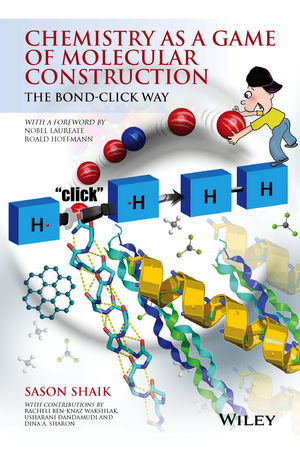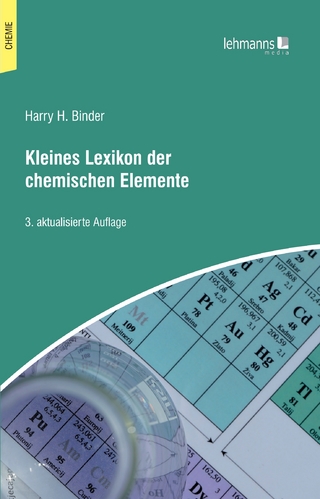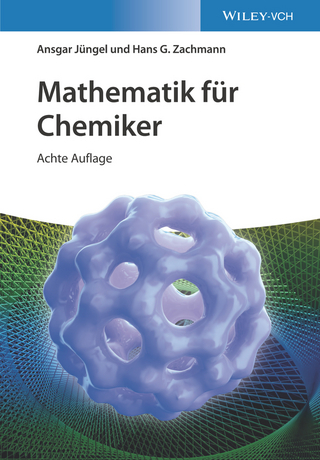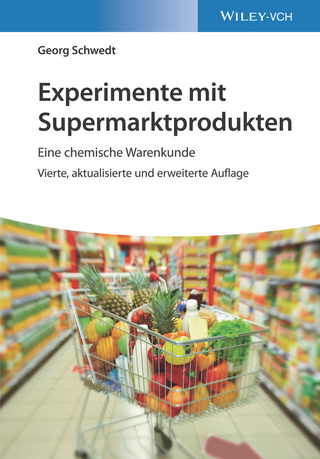
Chemistry as a Game of Molecular Construction
John Wiley & Sons Inc (Verlag)
978-1-119-00140-9 (ISBN)
Chemistry as a Game of Molecular Construction: The Bond-Click Way utilizes an innovative and engaging approach to introduce students to the basic concepts and universal aspects of chemistry, with an emphasis on molecules’ beauty and their importance in our lives.
• Offers a unique approach that portrays chemistry as a window into mankind’s material-chemical essence
• Reveals the beauty of molecules through the “click” method, a teaching methodology comprised of the process of constructing molecules from building blocks
• Styles molecular construction in a way that reveals the universal aspect of chemistry
• Allows students to construct molecules, from the simple hydrogen molecule all the way to complex strands of DNA, thereby showing the overarching unity of matter
• Provides problems sets and solutions for each chapter
Sason S. Shaik, PhD, is a Professor and the Director of the Lise Meitner-Minerva Center for Computational Quantum Chemistry in the Hebrew University in Jerusalem. He has been a Fulbright Fellow (1974-1979) and became a Fellow of the AAAS in 2005. Among his awards are the Israel Chemical Society Medal for the Outstanding Young Chemist (1987), the Alexander von Humboldt Senior Award in 1996-1999, the 2001 Kolthoff Award, the 2001 Israel Chemical Society Prize, and the 2007 Schrödinger Medal of WATOC. His research interests are in the use of quantum chemistry to develop paradigms that can pattern data and lead to the generation and solution of new problems. From 1981-1992, the main focus of his research was on valence bond theory and its relationship to MO theory, and during that time, he developed a general model of reactivity based on a blend of VB and MO elements. In 1994, he entered the field of oxidation and bond activation by metal oxo catalysts and enzymes, an area where he has contributed several seminal ideas (e.g., two-state reactivity) that led to resolution of major controversies and new predictions.
FOREWORD xv
PREFACE xvii
Comments to the Teachers/Students xvii
A Conversation on the Textbook and Its Intended Readers xx
LECTURE 1 MOLECULAR BLUES 1
1.1 Conversation on Contents of Lecture 1 1
1.2 The Universal Aspect of Chemistry 2
1.3 Love, Addiction, Psychological Balance, etc. 2
1.4 The Chemical Mechanism of Neurotransmission 8
1.5 Molecules of Pleasure, Wellness, and Pair Bonding 10
1.6 More Chemical Control 13
1.7 The Chemical Matter 15
1.8 Molecular Architecture and Its Emergent Properties 18
1.8.1 Diamond, Graphite, and More 18
1.8.2 And There Was Light… 19
1.9 Chirality, and the Magic by Which Molecules Recognize Others in Nature 21
1.10 Our Genetic Code Is Chemical 23
1.11 Chemistry and Its Emergent Expressions 24
1.12 References and Notes 26
1.A Appendix 29
1.A.1 Proposed Demonstrations 29
1.A.2 References for Appendix 1.A 31
1.R Retouches 31
1.R.1 More Drugs Looking like PEA 31
1.R.2 The Atomic Hypothesis 32
1.R.3 The Uncertainty Principle, The Exclusion Rule, and Valence 32
1.R.4 Units of Size 33
1.R.5 References for Retouches 33
LECTURE 2 THE CHEMICAL BOND AND THE LEGO PRINCIPLE 35
2.1 Conversation on Contents of Lecture 2 35
2.2 The Periodic Table: The Storehouse of Atoms 36
2.2.1 The Chemical Language 38
2.3 The LEGO Principle 40
2.3.1 The Covalent Bond in H2 41
2.4 The Bonding Capability of Atoms and The Law of Nirvana for Main Group Elements 44
2.4.1 The Valence Shell and Connectivity in a Family 45
2.4.2 The Octet and Duet Rules: The Law of Nirvana 46
2.5 Making Molecules Using the Available Atom Connectivity and The Law of Nirvana 48
2.5.1 Using the Table of Connectivity to Make Molecules That Attain Nirvana 50
2.5.2 Bonding in Atoms with Multiple Connectivity 53
2.6 The Principle of Conservation of the Number of Atoms in Chemical Reactions 56
2.7 Summary 57
2.8 References 59
2.A Appendix 59
2.R Retouches 60
2.R.1 Elements versus Atoms 60
2.R.2 Electron Pairing 61
2.R.3 Enzymes and Catalysis 61
2.R.4 Alchemy 62
2.R.5 References for Retouches 63
2.P Problem Set 63
LECTURE 3 ELECTRON-DEFICIENT MOLECULES, GIANT MOLECULES, AND CONNECTIVITY OF LARGE FRAGMENTS 65
3.1 Conversation on Contents of Lecture 3 65
3.2 Electron-Deficient Molecules 66
3.2.1 Electron-Deficient Free Radicals 68
3.3 The Power of Multiple Connectivity: SiO2—A Giant Molecule 69
3.3.1 SiO2—A Giant Molecule 69
3.3.2 Definitions of Terms That Follow from the SiO2 Story: Stoichiometry and Polymers 71
3.4 SiO2 and Glass Making 73
3.5 Glass Making from Water Glass 74
3.6 Must We Work So Hard to Construct Large Molecules? 75
3.6.1 Creating Larger Modular Building Blocks 75
3.6.2 Making New Molecules from the New Modular Fragments 75
3.7 Summary 80
3.8 References 81
3.A Appendix 81
3.A.1 Proposed Demonstrations 81
3.A.2 References for Appendix 3.A 82
3.R Retouches 82
3.R.1 Formal Charges 82
3.R.2 Multiple Bonds to Silicon 83
3.R.3 The Lone-Pair Bond Weakening Effect 83
3.R.4 The O2 Molecule and Its Magnetism 84
3.R.5 References for Retouches 86
3.P Problem Set 86
LECTURE 4 CONSTRUCTING MOLECULAR WORLDS OF CARBON–HYDROGEN FROM LARGE LEGO FRAGMENTS 87
4.1 Conversation on Contents of Lecture 4 87
4.2 Molecular Chains Involving Only C and H 89
4.2.1 Extended Chains 89
4.2.2 Branched Chains and Isomerism 91
4.2.3 Isomers of Octane (C8H18) 93
4.2.4 Some Applications of Alkanes 94
4.3 Molecular Rings and Cages Made From CH2 and CH Fragments 96
4.3.1 Molecular Rings Made of CH2 Fragments 96
4.3.2 Molecular Cages Made of CH Fragments 97
4.4 Molecular Planes and Cages Made from C Fragments 100
4.5 Isomers of Rings and Cages 105
4.6 Infinity of Molecular Worlds Made from C and H 106
4.7 Summary 108
4.8 References 108
4.R Retouches 108
4.R.1 Atomic Weight, Isotopes, Atomic Mass Unit, and Molecular Weights 108
4.R.2 Avogadro’s Number 109
4.R.3 The Mole Concept 110
4.R.4 Calculation of CO2 Emission by a Car 111
4.R.5 The Molecule Benzene, Kekul´e’s Dream, and Resonance Theory 112
4.R.6 Resonance Theory and Collective Bonding 114
4.R.7 References for Retouches 115
4.P Problem Set 115
LECTURE 5 CONSTRUCTING MOLECULAR WORLDS OF LIFE FROM LARGE LEGO FRAGMENTS 117
5.1 Conversation on Contents of Lecture 5 117
5.2 Alcohols, Aldehydes, Ketones, Ethers, and Amines 120
5.2.1 Alcohols 120
5.2.2 Ethers 122
5.2.3 Amines 124
5.2.4 Biogenic Amines: Our Neurotransmitters 124
5.2.5 Aldehydes, Ketones, Acids, and Esters 128
5.2.6 Fats (Lipids): Fatty Acids, Prostaglandins, Triglycerides, Cholesterol, Cortisone, etc. 130
5.2.7 Amino Acids, Peptides, Proteins, and Enzymes 136
5.3 Summary 145
5.4 References 145
5.A Appendix 146
5.A.1 The Natural Amino Acids (NAAs) 146
5.R Retouches 146
5.R.1 P450 Enzymes and Grapefruit Juice 146
5.R.2 The Discovery of O2 146
5.R.3 References for Retouches 150
5.P Problem Set 150
LECTURE 6 ELECTRON RICHNESS, DNA AND RNA MOLECULES, AND SYNTHETIC POLYMERS 153
6.1 Conversation on Contents of Lecture 6 153
6.2 Electron Richness: A Different State of Nirvana 155
6.2.1 “Who Is Who in Electron Richness” 155
6.2.2 Examples of Electron-Rich Molecules 156
6.2.3 Phosphoric and Sulfuric Acids 157
6.3 DNA and RNA Strands 159
6.3.1 Formation of DNA and RNA Strands 161
6.3.2 DNA and RNA Nucleotide-Based Drugs 161
6.4 Synthetic Polymers 164
6.4.1 Constructing Polymers Using the LEGO Principles 165
6.4.2 Polymers and Additives 171
6.5 Summary 172
6.6 References and Notes 173
6.A Appendix 174
6.A.1 Proposed Demonstrations 174
6.A.2 References for Appendix 6.A 175
6.R Retouches 175
6.R.1 To Be or Not to Be in Octet? This Is the Question 175
6.P Problem Set 177
LECTURE 7 THE 3D STRUCTURE OF MOLECULES, ELECTRONEGATIVITY, HYDROGEN BONDS, AND MOLECULAR ARCHITECTURE 179
7.1 Conversation on Contents of Lecture 7 179
7.2 3D Structures of Molecules 186
7.2.1 Selection Rules of 3D Molecular Structures 186
7.2.2 Lone Pairs Count in 3D Structure Determination 189
7.2.3 A Multiple Bond Counts as a Single Space Unit 191
7.2.4 Isomerism in Double-Bonded Molecules 192
7.2.5 Nature’s Usage of Cis and Trans Isomers 194
7.3 Handedness (Chirality) and Isomerism 195
7.3.1 Handedness (Chirality) in Nature 197
7.4 Extension of the 3D Rules to Conformations 200
7.5 The Architecture of Matter and Its Origins 202
7.5.1 The Electronegativity of Atoms 203
7.5.2 Polarity Trends in Bonds 204
7.5.3 Molecular Polarity 205
7.5.4 Intermolecular Interactions and the Hydrogen Bond 206
7.5.5 Properties of Water 207
7.5.6 H-Bonds in Proteins 208
7.6 H-Bonding and Our Genetic Code 209
7.7 Summary 213
7.8 References and Note 214
7.A Appendix 215
7.A.1 The Periodic Table of Electronegativity Values 215
7.A.2 Proposed Demonstrations for Lecture 7 215
7.A.3 References for Appendix 7.A 218
7.R Retouches 218
7.R.1 Electron Pair Repulsion 218
7.R.2 Pictorial Description of Lone Pairs 218
7.R.3 The Nature of the Double Bond 219
7.R.4 Conformations of C2H6 219
7.R.5 Other Intermolecular Forces 220
7.R.6 More on DNA 221
7.R.7 References for Retouches 225
7.P Problem Set 225
LECTURE 8 THE IONIC BOND AND IONIC MATTER 227
8.1 Conversation on Contents of Lecture 8 227
8.2 Ionic Bonds versus Covalent Bonds 232
8.2.1 The Formation of Ionic Bonds. How and When? 232
8.2.2 Construction of Ionic Bonds by “Click-Clack” 235
8.2.3 Ionic Molecules Containing Complex Ions 236
8.2.4 Why Are Ionic Materials Generally Solids? 238
8.2.5 Ionic Liquids? 240
8.2.6 Solubility and Insolubility of Ionic Materials 240
8.3 The Use of Ionic Matter in Living Organisms 242
8.3.1 Soluble Ionic Material Takes Care of Biological Communication 242
8.3.2 The Insoluble Ionic Material Makes Our Skeleton and Teeth 243
8.4 Covalent Molecules that Form Ions in Solution: Acids and Bases 244
8.4.1 Acids in Water: A Proton Transfer Reaction from the Acid to Water 244
8.4.2 Bases in Water: A Proton Transfer Reaction from Water to the Base 248
8.4.3 A Proton Transfer Reaction from Acids to Bases 249
8.4.4 A Few Facts About Our Acids and Bases 250
8.5 Summary 251
8.6 References and Notes 252
8.A Appendix 253
8.A.1 Proposed Demonstrations for Lecture 8 253
8.A.2 References for Appendix 8.A 254
8.R Retouches 255
8.R.1 Energetic Aspects of Ionic Bonding 255
8.R.2 Energy Units and Bond Energy Calculation for Ionic Bonds 257
8.R.3 Dissolution of Ionic Solids in Water 259
8.R.4 Concentration, the pH Scale, and Indicators 260
8.R.5 Symbolic Representations of Chemical Reactions Using Curved Arrows 262
8.R.6 References for Retouches 264
8.P Problem Set 264
LECTURE 9 BONDING IN TRANSITION METALS, SPECTROSCOPY, AND MOLECULAR DIMENSIONS 265
9.1 Conversation on Contents of Lecture 9 265
9.2 The 18-Electron Rule for Transition Metal Bonding 275
9.2.1 An Example of a Transition Metal Complex That Obeys the 18e Rule 276
9.2.2 Electron Counts of Ligand Contributions 277
9.3 Construction of Transition Metal Complexes That Obey the 18e Rule 279
9.4 Transition Metal Complexes with 14–16e 280
9.4.1 Comments on TM-Based Catalysts 282
9.5 3D Shapes of Transition Metal Complexes 283
9.6 Bridging Transition Metal and Organic Molecules: Bonding Capabilities of Fragments of Transition Metal Complexes 285
9.7 Summary of Transition Metal Complexes 288
9.8 Spectroscopy or How Do Chemists “Listen to Molecules”? 288
9.8.1 The Electromagnetic Radiation Spectrum 288
9.8.2 Energy Levels of Molecules as the Basis of Spectroscopy 291
9.8.3 X-Ray Crystallography and 3D Molecular Information 294
9.9 Summary of Spectroscopic Methods 297
9.10 References and Notes 297
9.A Appendix 298
9.A.1 Radii Values for Transition Metals in Covalent and Ionic Bonds 298
9.A.2 Bond Dissociation Energies and Their Usage as Building Blocks 298
9.A.3 Proposed Demonstrations for Lecture 9 300
9.A.4 References for Appendix 9.A 302
9.R Retouches 302
9.R.1 Why the 18e Rule, and Why Are Many TM Complexes Colored? 302
9.R.2 High-Spin Complexes 304
9.R.3 The Active Species of CYP 450 305
9.R.4 The “Life” of a Catalyst: The Catalytic Cycle 305
9.R.5 The Relation Between the Energy of the Photon and the Frequency of the Light 308
9.R.6 References for Retouches 308
9.P Problem Set 308
LECTURE 10 CHEMISTRY, THE TWO-FACED JANUS—THE DAMAGE IT CAUSES VERSUS ITS IMMENSE CONTRIBUTION TO MANKIND 311
10.1 Conversation on Contents of Lecture 10 311
10.2 Types of Potential Chemical Damage 316
10.2.1 The Ozone Hole 316
10.2.2 The Montreal Protocol 319
10.2.3 Climate Change 319
10.2.4 Acid Rain 321
10.2.5 More Evils and the Other Side of the Chemical Janus 322
10.3 Summary 324
10.4 References and Notes 324
10.R Retouches 325
10.R.1 The Electronic Structure of Ozone 325
10.R.2 Reference for Retouches 325
10.P Problem Set 326
LECTURE 11 CHEMISTRY IS EVERYTHING AND EVERYTHING IS CHEMISTRY 327
11.1 Conversation on Contents of Lecture 11 327
11.2 The Birth of Chemistry Is the Nascence of Mankind 328
11.3 Chemistry Is Everything 331
11.4 The Magic of Chemistry and Pathological Science 334
11.5 The Love of Chemistry 337
11.6 Summary 339
11.7 References and Notes 340
11.A Appendix 340
11.A.1 Proposed Demonstrations for Lecture 11 340
11.A.2 References for Appendix 11.A 342
EPILOGUE 343
ANSWERS TO PROBLEM SETS 345
INDEX 377
| Erscheint lt. Verlag | 6.5.2016 |
|---|---|
| Co-Autor | Racheli Ben-Knaz Wakshlak, Usharani Dandamudi, Dina A. Sharon |
| Vorwort | Roald Hoffmann |
| Verlagsort | New York |
| Sprache | englisch |
| Maße | 152 x 234 mm |
| Gewicht | 726 g |
| Themenwelt | Naturwissenschaften ► Chemie ► Allgemeines / Lexika |
| Naturwissenschaften ► Chemie ► Technische Chemie | |
| Technik ► Maschinenbau | |
| ISBN-10 | 1-119-00140-4 / 1119001404 |
| ISBN-13 | 978-1-119-00140-9 / 9781119001409 |
| Zustand | Neuware |
| Haben Sie eine Frage zum Produkt? |
aus dem Bereich


